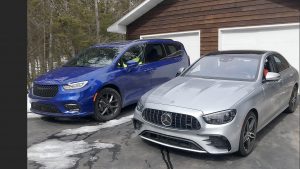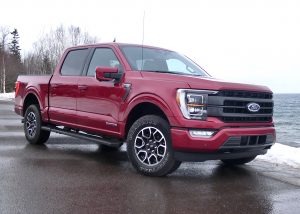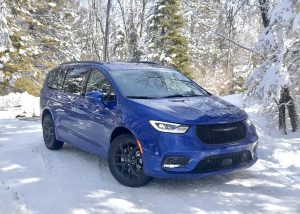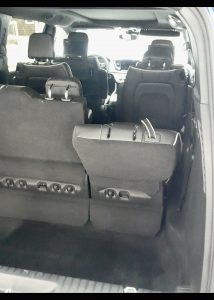Top-rung Ford F-150 adds hybrid power
Filed under: Weekly test drives, Autos
By John Gilbert
What would you get if you crossed the concepts of the largest-selling vehicle in the world — the Ford F-150 half-ton pickup truck — with, say, a Prius? If you guess a tiny pickup, you’d be wrong; if you guess a gigantic super-powered hybrid pickup, you get a gold star.
The competition among top pickup manufacturers has never been more ferocious, even though the F-150 continues to hold serve for four decades as the top-selling vehicle in the country, and the world. The new Chevrolet Silverado is making a move up to regain the runner-up spot it yielded to the Ram 1500 a year ago, but the Ram was just awarded Motor Trend’s Truck of the Year for 2021, an unprecedented third straight year for Ram to win that honor.,
If you keep track of such things, you might have found it curious that Motor Trend ran the Ford Super-Duty heavyweight F-250 and F-350 against the winning Ram, but for competition it only offered the 2020 F-150. That’s because Ford was preparing to unveil the new 2021 F-150, and it was cloaked in some secrecy along the way. It came out just in time to win the North American Truck of the Year competition.
The opportunity to spend time with an F-150 PowerBoost for a week provided convincing evidence that the big Ford is also staking claim to the title of highest of high-tech pickups. My first suspicion was when I saw the plaque on the side that said “PowerBoost,” which is different from EcoBoost, Ford’s name for its turbocharging process on various engines. I had heard that Ford was thinking about adding a hybrid version to its vast array of F-150 models, so I followed up, and, sure enough, the PowerBoost is the new hybrid. Read more
Right tires go beyond all-wheel-drive security
Filed under: Weekly test drives, Autos

Both 2021 Pacifica, left, and Mercedes AMG E53 sedan have all-wheel-drive available, but the tires make huge difference on ice.
By John Gilbert
How many people do you know who have had to call Triple-A to get their car extricated from a bad situation? A lot, I imagine. But how about from their own driveway? Now we’re getting somewhere, he added, raising his hand at his own question.
When springtime comes to the Great White North, we all shift into a celebratory mood, having conquered another round of winter for another year — albeit the weirdest year of our lives. But sometimes we, and the auto companies we know and love, get outflanked when they take Mother Nature for granted.
March arrived like a lamb in Duluth, Minnesota, as we broke a hundred-and-some-year-old record for the warmest temperature on that date, reaching 55 degrees. The two agencies that bring me new vehicles to test drive brought me a succession of three cars. One brought a Mercedes AMG E53 Sedan, and a new Chrysler Pacifica, the Limited version van with an S package. They both, by chance, had all-wheel drive.
The other delivery outfit brought me a new Mazda3, a very neat subcompact with the company’s new 2.5-liter turbocharged engine and, believe it or not, all-wheel drive. I joked to my wife, Joan, that here we were, breaking temperature records for mild weather and we have three AWD cars.
I was going out to catch a Division III women’s college hockey playoff game, and I decided to drive the Mazda3. I scoffed at the warning of possible snow, but wanted to keep the Mercedes pristine, and the stunning blue Pacifica also out of any weather risk. It did start snowing, gigantic flakes, and they came harder and harder, causing me to leave the game halfway through. The Mazda3 and I slid around a disturbing amount in the deepening and unplowed snow, but I made it home up our rural hill on the North Shore of Lake Superior, and drove in the 100 yards of my straight driveway, parking at an odd angle to allow our incredible neighbors space to work their plowing magic.
Next morning, we were buried under 7.5 inches of the heaviest, cement-like snow I’ve ever shoveled. And shoveled. And shoveled. Joan had to get to work, and she’s an excellent all-weather driver, but I suggested I’d drive her the 10 miles to work, and pick her up. My choice was the Pacifica, being higher off the ground, and a good opportunity to test its new limited-slip all-wheel-drive system, which uncouples the rear axle when the computer tells it there’s no risk of losing traction.
I backed around the two parked vehicles and got the Pacifica aimed to back straight out of the driveway, and as I started, I figured I’d better get some momentum going for the highway snowplow’s inconvenient pile at the road. I hit the gas, and in an instant, the Pacifica shot sideways — 6 feet to the right and just enough to put the right wheels over the edge of the asphalt lip of the driveway, nestled down into the snow. I was amazed at how the limited-slip concept was overwhelmed by my unlimited-slip snow-covering, resulting in the Pacifica possibly spending the rest of the winter at our home.
I already knew the Mazda’s Bridgestone Turanza tires were not the grippiest, so I said we should take the Mercedes. Its $82,370 sticker priced was no assurance of passing this severe test! We climbed aboard and I set the mode switch to “slippery,” got it onto the straight part of the driveway and I built the speed gradually as we kept moving, churning smoothly to the end of the driveway and through the plowed pile. I turned left to head down the hill, and we drove to Joan’s workplace without ever even spinning a tire. Read more





 John Gilbert is a lifetime Minnesotan and career journalist, specializing in cars and sports during and since spending 30 years at the Minneapolis Tribune, now the Star Tribune. More recently, he has continued translating the high-tech world of autos and sharing his passionate insights as a freelance writer/photographer/broadcaster. A member of the prestigious North American Car and Truck of the Year jury since 1993. John can be heard Monday-Friday from 9-11am on 610 KDAL(www.kdal610.com) on the "John Gilbert Show," and writes a column in the Duluth Reader.
John Gilbert is a lifetime Minnesotan and career journalist, specializing in cars and sports during and since spending 30 years at the Minneapolis Tribune, now the Star Tribune. More recently, he has continued translating the high-tech world of autos and sharing his passionate insights as a freelance writer/photographer/broadcaster. A member of the prestigious North American Car and Truck of the Year jury since 1993. John can be heard Monday-Friday from 9-11am on 610 KDAL(www.kdal610.com) on the "John Gilbert Show," and writes a column in the Duluth Reader.